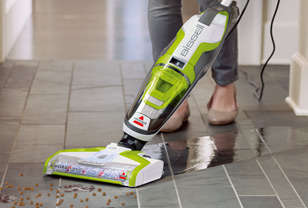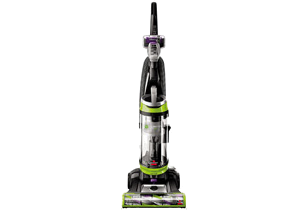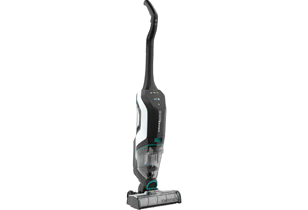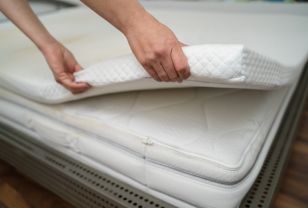Can You Use a Bissell CrossWave on Carpet? Yes — With Smart Limits
The Short Answer
Yes, it does work for low-pile carpet, thin area rugs, day-to-day crumbs, surface pet hair, and light odor refresh.
No, or not ideal for: shag/high-pile, dense loop/Berber, embedded grit, and set-in stains.
Use Area Rug mode, limit wet passes to brief periods, and perform two or more slow dry extraction passes. Improve ventilation after cleaning.
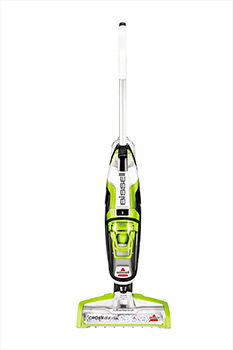
Bissell CrossWave is one of the best vacuum-mop combos we’ve tested in a while
How the Bissell CrossWave Works
Bissell CrossWave is a 2-in-1 wet-dry floor cleaner. It brushes with a brush roll, releases a small amount of cleaning solution, and then vacuums the mixture of liquids and solids. This process is very efficient on hard floors, whereas on carpet it’s effective only in small, suitable areas.
It is able to lift surface dirt, tame light odors, and refresh traffic lanes on low-nap synthetic carpets like nylon, polyester/PET, and olefin/polypropylene.
It does not substitute for a carpet extractor that employs heat when required to remove deep-rooted stains, heavy soils, or soils in shag or high-pile fiber beds.

The CrossWave is a mop-vacuum hybrid
When the CrossWave Works With Carpet
Synthetic carpets (especially low-nap nylon, polyester, or olefin) that are low-pile are most responsive. The brush can contact the fiber tips, moisture remains near the surface, and extraction is effective.
You can clean dust, crumbs, and pet dander on thin area rugs and flat weaves, provided the backing is stable and the color is colorfast. Make one light wet pass and repeat dry extraction passes a few times. Cover corners to avoid curling.
Light odor refresh: A mild damp or “pet-house” odor (not wet animal odor) can be diminished with a mild solution, thorough drying, and sufficient airing.
Maintenance between deep cleans: Every week or every other week, perform CrossWave maintenance cleaning; once or twice per season, perform periodic deep extractions.

The CrossWave will do fine on sparse, low-pile carpets
When It Struggles or Should Be Avoided
Shag/High-Pile: The brush can’t reach the backing, solution localizes, and the carpet may wick back or require extensive dry times.
Dense loop/Berber: Loop fibers hold liquid and limit agitation. If you must clean, use very little solution and take very gradual extraction passes. A true carpet extractor is safer.
Old stains and embedded grit: For set-in or tracked-in messes, professional pretreatments and a hot extractor are normally needed.
Wool and sensitive fibers: Use extra care—pH-neutral formulations, minimal water, and always color test.
Step-by-Step: Using the CrossWave on Carpet
- Pre-Vacuum Thoroughly
Remove loose dirt, hair, and crumbs before adding moisture. Use a dedicated dry vacuum—or your Bissell CrossWave used dry/empty—to prevent fine dust from turning into mud that sods up fiber bases. - Check Colorfastness in a Small Area
Sponge a little solution onto a hidden corner, then blot and observe for dye transfer or fuzzing. If anything looks questionable, stop and switch methods before proceeding with the Bissell CrossWave on carpet. - Select the Right Mode & Solution
Choose Area Rug mode (or your model’s carpet-appropriate setting). Use a manufacturer-approved cleaner, or a pH-neutral formula for synthetics. Avoid high-acid mixtures near natural stone or unsealed grout. - Meter the Moisture
Make one short, controlled wet pass with brief trigger pulses; avoid soaking the carpet. Aim for light dampness, not saturation. - Slow Dry Extraction Passes
Release the trigger (no solution) and make two or more slow, overlapping dry extraction passes to pull moisture out and avoid striping. - Mind the Speed
Extraction speed should be slow—about 2–3 inches per second—adjusting based on how glassy/wet the fibers look. - Ventilate Aggressively
Open windows, run fans, and if humidity is high, use a dehumidifier. Done correctly, a maintenance clean should leave low-pile carpet touch-dry in ~30–90 minutes, depending on face weight and room humidity. - Groom if Necessary
Gentle carpet raking or brushing can help reset the nap and speed drying when it’s slightly damp.
Fibers & Construction 101: Why This Matters
Carpet performance hinges on fiber type, construction, and mass.
- Nylon: Strong, resilient, common in rentals; easy to clean and reasonably quick to dry.
- Polyester: Budget-friendly; highly resistant to many water-based stains; can retain surface water films.
- Olefin (polypropylene): Handles moisture and resists wick-back, but is prone to matting—keep passes light.
- Wool: Sensitive, absorbent, natural; use pH-neutral wool-safe chemistry; avoid excess moisture.
Construction
- Cut pile/low pile: Ideal candidates—light brushing agitates, and extraction is most efficient.
- Loop/Berber: Dense loops trap liquid; use minimal solution and prefer extractors.
- Shag/high-pile: Should not be wet cleaned using a Bissell CrossWave.
Denser and larger carpets store more water and take longer to dry when using the Bissell CrossWave on carpet. Keep wet passes brief and dry extraction slow and thorough.
Exception Cases
Rugs, runners, thresholds, stairs: Thin area rugs need secured corners or a pad to prevent movement. Slightly lift the head near edges to avoid catching.
Stairs and runners: These can get overly wet. Use a very weak solution and emphasize multiple dry extraction passes. A handheld spot extractor may be the better option.
Thresholds and transitions: Don’t pool solution at seams or carpet-to-hard-floor transitions; repeated oversaturation can cause adhesive failure.
Dry-only: When water isn’t needed, a dry-only pass suffices. For dust, crumbs, and surface pet hair on low-pile carpet, start with a clean tank and don’t press the trigger. This avoids residue and keeps dry time near zero.
CrossWave Pet Pro vs. Standard (On Carpet)
What’s the same: Physics limits both models; neither digs out deeply embedded soil. Over low-pile surfaces, either model is fine if you meter water carefully and extract thoroughly.
Where the Pet Pro helps: Tangle-resistant brush and pet-focused design handle shedding on short-nap synthetics. Light odor refresh is possible with pet-specific formulas.
What it cannot do yet: Lift old backing stains, eliminate embedded grit, or extract urine that has soaked into cushion or subfloor. Those issues require pretreatments, a hot extractor, and pad-level odor control.
Moisture Management — Wick-Back — Adhesion
Wick-back occurs when water dissolves soil deep in the pile; as the carpet dries, the soil solution rises and leaves a ring or haze. To prevent wicking:
- Keep solution low. Go slow on dry extraction. Maximize ventilation.
- Avoid flooding seams or transitions; excessive wetting can cause delamination (adhesive failure).
- If marks reappear, remove them, then run another slow dry extraction with improved airflow instead of adding liquid.

If you need something that can clean carpet, the Bissell ProHeat 2X Revolution will be a better choice overall
Solutions: What to Use (and What to Skip)
Follow carpet/rug manufacturer recommendations. For synthetics, use pH-balanced products. Avoid high-acid and highly fragrant mixes—especially near natural stone or grout. Castile soap is fine in small amounts, but rinse and extract completely to prevent streaks and residues. Avoid mixing baking soda into soap-based solutions. Apply powder detergents dry; if you add liquid later, extract thoroughly. You can also vacuum or run the Bissell CrossWave with clean water as a rinse.
In humid environments, plan airflow: open two windows/doors across the room for cross-ventilation; position a blower near the floor to push air along the carpet. In winter, set your HVAC blower to “On” for 30–60 minutes (change the filter first!). For carpets with cellulosic (jute/cotton) backings, watch for browning during drying. Limit moisture and, if browning begins, increase extraction time. For households with children or pets—or if you prefer gentle scents—select unscented or low-odor alternatives.

The Bissell CrossWave works excellently against pet residues: kibbles, hair, and pee alike
Maintenance: Keep the Machine Clean to Avoid Streaks and Odors
After each use—especially after running the bissell crosswave on carpet—empty and rinse the dirty-water tank. Remove the brush roll and window; rinse well and let them drip-dry (overnight is best). Rinse filters/screens and allow 24 hours to dry. Never reinstall a wet filter—this causes streaks and mildew odors. Wipe the chamber. Store with tanks open or parts on a drying rack. Replace filters or brush rolls if bristles look fuzzy or filters won’t rinse clean. Monthly, “health-check” seals and gaskets for nicks, remove hair from wheels/axles, and ensure the trigger isn’t sticking (which can over-saturate carpet). If your manual allows, flush the solution line with warm water monthly to prevent buildup.

If the CrossWave’s brush roll is dirty, it will leave streak
Troubleshooting Streaks & Clouding
Streaks or clouding usually mean too much solution, dirty parts, or leftover residue. Switch to Area Rug mode (reduced solution), shorten wet passes, and add extra-slow dry extraction passes. Clean the brush roll, window, filter, and dirtiest parts until rinse water runs clear, then air-dry completely. Improve room ventilation with fans and, if needed, a dehumidifier.
A One-Minute Decision Tree
Step 1 — Identify fiber & pile
Low piles of nylon, polyester (PET), or olefin (polypropylene) are a definite go. Wool, Berber, and shag/high piles are better handled with a heated carpet extractor or a professional.
Step 2 — Define the goal
- Rapid refresh & odor control: One gentle wet stroke + two slow drying extraction strokes + fan.
- Stain removal or heavy soil: Pretreat + hot extractor (the Bissell CrossWave is not suited for this).
Step 3 — Manage drying
Pre-stage fans or a dehumidifier. Avoid traffic for 30–90 minutes, until touch-dry. Heavier face weights may need longer.
Safe Practices & Chemistry Notes
If you’re wondering can you use bissell crosswave on carpet, always test for color or texture changes in an inconspicuous area before a full pass. Keep alcohol-based or fragrant cleaners away from flames and ensure good air circulation. Avoid acidic solutions near natural stone or grout. When testing DIY cleaners, use sparingly and follow with water extraction. When in doubt, a commercial carpet solution is best.
Combining All This Information: A Daily Practice
Pre-vacuum thoroughly or run a Dry-Only CrossWave pass. Do a colorfastness spot check. In Area Rug mode, make one short wet pass per lane. Follow with two gentle drying extraction passes. Ventilate (fans/windows; dehumidifier if humid). Light grooming to reset nap. Clean the machine and air-dry parts. Avoid traffic until touch-dry.
The Bottom Line
A Bissell CrossWave can be part of a smart carpet care strategy—a cleaning tool for suitable carpeting. When using the Bissell CrossWave on carpet, TheKingLive recommends maintaining low moisture levels and avoiding wet extraction methods. Excess drying time can be minimized. Higher ventilation is always preferable. It is suitable for low piles and small mats. Avoid wet cleaning shag/high piles and dense loop/Berber carpets unless you're extremely sure. Wet cleaning of wool carpeting is not recommended unless you're extremely sure or you're utilizing a hot carpet extraction machine.
FREQUENTLY ASKED QUESTIONS
- 01. Can the Bissell CrossWave be used as a dry vacuum on carpeting?
-
“Yes. Run it with no solution and the trigger released. It's good on crumbs, dust, and surface hairs on low-pile carpeting.”
- 02. Does it work well on wool?
-
Proceed with caution. Use pH-neutral solutions only, in small quantities. Perform colorfastness tests and focus on drying extraction. When in doubt, call a pro.
- 03. Are Berber or loop Berber carpet alternatives??
-
Use minimal solution. Loops can retain soil and take longer to dry. A heated soil extraction tool is safer for true soiling.
- 04. Why do streaks keep appearing?
-
Usually from over-wetting or contaminated parts. Reduce solution use, lengthen drying extraction cycles, clean the brush, window, and filter, and improve ventilation.
- 05. How often should I replace the brush or filter?
-
Replace when bristles are matted or the filter remains discolored after rinsing. Homes with heavy pet traffic will need more frequent replacements.
- 06. What is “face weight”?
-
It’s the weight of fibers per area. As face weight increases, carpets retain more moisture and require longer drying times.






